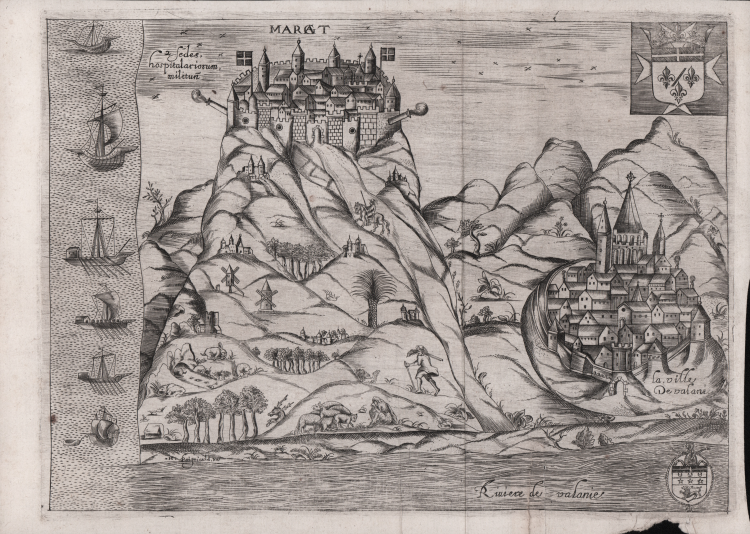



| Reference: | S40335.4 |
| Author | Henri RAIGNAULD |
| Year: | 1629 |
| Zone: | Castle of Margat |
| Printed: | Paris |
| Measures: | 270 x 200 mm |


| Reference: | S40335.4 |
| Author | Henri RAIGNAULD |
| Year: | 1629 |
| Zone: | Castle of Margat |
| Printed: | Paris |
| Measures: | 270 x 200 mm |
Viewv of the castle of Margat in modern Syria, engraved by Henry Raignauld, which appeared in J. Badouin's rare Histoire des Chevaliers de l'Ordre de S. Jean de Jerusalem, published in Paris in 1629.
This is the first French edition by Pierre de Boissat (1603-1662) and Jean Baudoin, the great history of the Order of Malta in three parts by Giacomo Bosio (1544-1627). It originally appeared in Italian, in Rome in 1621. Born in Chiavari to a noble Piedmontese family, Bosio was a brother of service of the Order of Malta. In 1587 he was appointed representative of the Order in Rome, where he composed his work on the history of the island of Malta, in the form of a manuscript.
Margat was located on a hill about 500 metres above sea level, formed by an extinct volcano on the road between Tripoli and Latakia, overlooking the Mediterranean Sea. It was probably an ancient fortress, but earliest existing defences were built in 1062 by the Arabs, who continued to hold it within the Christian Principality of Antioch in the aftermath of the First Crusade.
When the Principality was defeated at the Battle of Harran in 1104, the Byzantine Empire took advantage of their weakness and captured Margat from the Muslims. A few years later it was captured by Tancred, Prince of Galilee, regent of Antioch, and was incorporated into the Principality.
In the 1170s it was controlled by Reynald II Mazoir of Antioch as a vassal of the count of Tripoli, the fortress was so large that it had its own household officials and a number of rear-vassals. His son Bertrand sold it to the Hospitallers in 1186 as it was too expensive for the Mazoir family to maintain.
After some rebuilding and expansion by the Hospitallers, it became their headquarters in Syria.
Under Hospitaller control, its fourteen towers were thought to be impregnable; Saladin besieged the castle in 1188 but was unable to capture it, and it was one of the few remaining territories left in Christian hands after Saladin's conquests.
By the beginning of the 13th century the Hospitallers controlled the surrounding land and roads and made a large profit from travellers and pilgrims passing through. Isaac Comnenus of Cyprus was imprisoned there after Richard I of England captured Cyprus from him during the Third Crusade. The bishop of nearby Valenia also used Margat as his headquarters after around 1240. Margat was second in size in power only to the other Hospitaller fortress to the south, Krak des Chevaliers.
Nice example with margins, perfect condition. Rare.
Henri RAIGNAULD(attivo nella prima metà del XVII secolo)
Henri RAIGNAULD(attivo nella prima metà del XVII secolo)